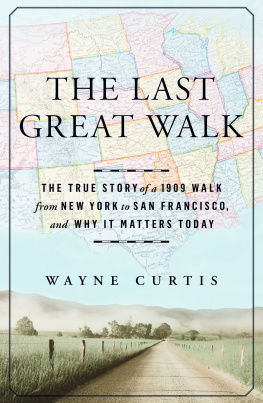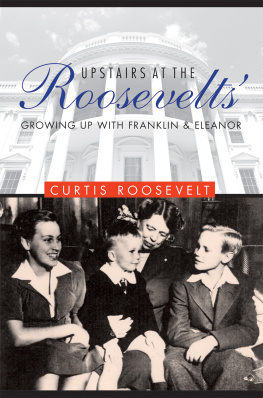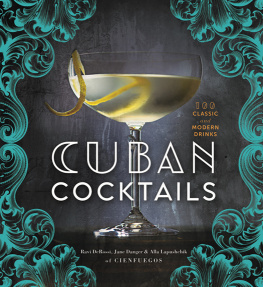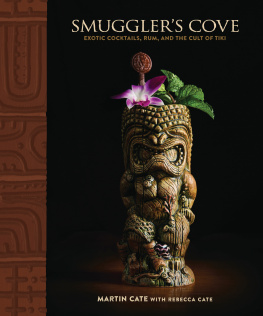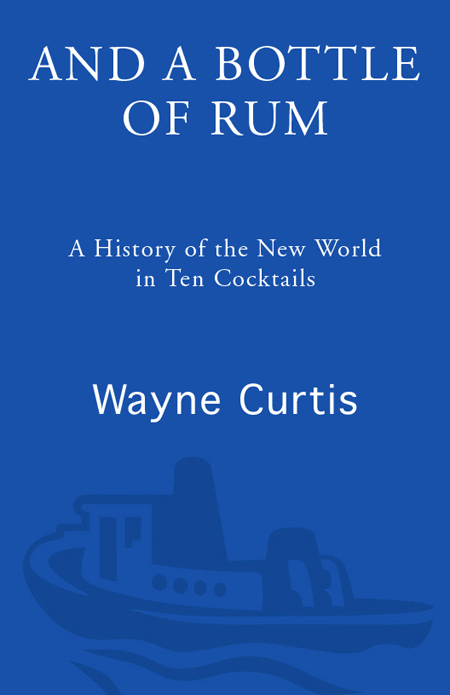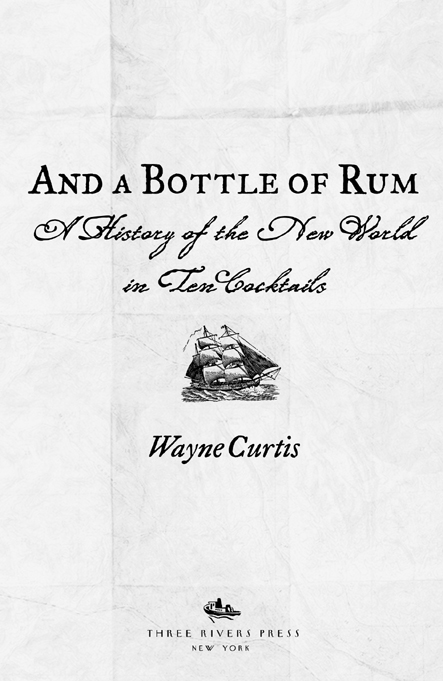Introduction
[Molasses]
How beverage alcohol is produced, distributed, consumed, and regulated offers a key to the nature of a society and how it changes over time.
J ACK S. B LOCKER J R. ,
J OURNAL OF U RBAN H ISTORY , 2003
Rum makes a fine hot drink, a fine cold drink, and is not so bad from the neck of a bottle.
F ORTUNE MAGAZINE , 1933
I 'm standing in front of the City Tavern Restaurant in Philadelphia's Old City. It's an austerely classical building, with tall stone steps rising from the sidewalk to a recessed door. At the top of the steps stands a young man with his hands behind his back. He has a sallow complexion and wears a short blue jacket with meringuelike ruffles about the neck. He has the air of a sentry, of someone with whom I must negotiate in order to get past the door.
People in period dress always unsettle me. I dread the moment they make eye contact, then snap into historic character and start speaking with a surplus of enunciatory gusto about an esteemed gentleman you've perhaps heard of by the name of Thomas Jefferson or some such thing. I understand some people enjoy this palaver. I am not one of them.
The tavern is a faithful reconstruction of the old tavern on the same spot, built from the ground up by the National Park Service in 1976. When the original tavern opened in 1773, it was arguably the finest in all the colonies and quickly became a social hub for the city and, in turn, for a young nation. Colonial representatives to the Continental Congress lodged and ate here during their deliberations, and through the tavern's doors passed such illustrious Americans as Thomas Jefferson, George Washington, Paul Revere, and John Adams, the last of whom called this the most genteel tavern in America.
They arrived here seeking to craft a new nation. I have come seeking an old drink.
Rum is the history of America in a glass. It was invented by New World colonists for New World colonists. In the early colonies, it was a vital part of the economic and cultural life of the cities and villages alike, and it soon became an actor in the political life. Hoping to briefly visit that lost world, I ascend the steps of the tavern.
At the doorway Mr. Ruffles happily spares me ye olde time banter. He escorts me through the Subscription Room, where a melancholy woman in a mobcap plays something funereal on the harpsichord. Just beyond is the tavern, which is dusky and furnished with several nicely worn tables and benches. I am shown a seat in a corner, and handed a menu of rustic colonial fare, which includes West Indies pepperpot soup, prime rib with a Yorkshire pancake, and turkey potpie.
The food sounds appealing if a little severe, but I'm only interested in ordering a rum shrub, a popular colonial-era drink. The unusual name comes from the Arabic word for drink, shrab. Colonists would chop up fruit or berries (or a strong spice like ginger), boil the pieces in vinegar, then let it steep for a day. The concoction then would be boiled again with sugar, resulting in a dense, intensely flavorful syrup that could preserve the pleasing bite of the fruit into winter and beyond.
A little shrub added to a glass of water would make it come alive with taste and glimmer with a light pastel hue, and the concoction could be further enlivened with rum or brandy, and often was. Vinegarbased cocktails may not be the trend of the moment, but I am told by my ponytailed waiter, Chris, who was not at risk of lapsing into any unprovoked hilarity, that they accounted for 60 percent of the wine and spirit sales at the City Tavern. Chris further informs me that shrub was once a popular drink because it provided vitamin C throughout the year. Never mind that vitamin C wasn't actually identified until the 1920s. I nod my head gravely and order up a shrub.
The barkeep is housed in a sort of wooden cage in a corner, like a war criminal waiting to testify at a tribunal. He sets to work on my drink, but I can't see much. Other waiters lean on the counter in front of him and chat about deuces and four-tops, which strikes my ear as pleasingly colonial. My shrub readied at last, Chris brings it over and sets it down. Pale pink and effervescent, the drink looks refreshing, and at the first sip I'm pleased to discover that not the slightest hint of vinegar comes through. It's tart and sprightly, like a dilute fruit punch, and has the thirst-cutting precision of a gin and tonic.
This is no doubt an enjoyable introduction to rum's early history. Yet I despair slightly, for I am getting no closer to finding colonial rum. The rum in this shrub is Captain Morgan, which, despite the colonial name, tastes nothing like its ancestor. From a marketing point of view, this is probably not a bad thing. The old-fashioned rum Jefferson and Adams ordered would have been cloying, greasy, nasty-smelling stuff. Colonial rum, made with a crude pot still and seat-of-the-pants technology, would have been laden with impurities, and could have been whiffed a block away. This rum shrub had been gentrified, making the past more potable.
Nor was there much choice in rum drinks. Shrub was it. An actual eighteenth-century tavern would have had a small riot of rum concoctions, along with a taverner conversant with them. Rum was by far the most popular spirit of the era, and often the only spirit sold. Guests could have ordered up a mimbo, a sling, a bombo, a syllabub, a punch, a calibogus, a flip, a bellowstop, a sampson, or a stonewall. Colonial tavern keepers were every bit as imaginative as today's $12-a-cocktail bartender and would have added molasses and dried pumpkin and coarse sugar and water and a bit of citrus and whatever else was at hand to give the drink some depthand, more to the point, to mask the rum's taste. Few ingredients were off limits in pursuit of this goal.
To drink a rum shrub made with Captain Morgan was to linger in comfort at a safe distance from the past. Learning about rum at the City Tavern, it turns out, was like learning about the habits of wild bears at Walt Disney World's Country Bear Jamboree.
My journey would take longer than I thought.
A short while later I walk two blocks north for a wholly different rum experience. Cuba Libre is a trendy two-story restaurant and rum bar that opened in late 2000. This Friday evening it's packed with well-manicured professionals in suits, and I wedge myself sidewise to get through the downstairs crowd to the overflow bar on the mezzanine. The interior was created by a company called Dynamic Imagineering, which themed the place to convince customers that they were dining in a courtyard of Old Havana. It's all tile work and stucco, wrought-iron balconies and heavy wooden doors. Diners sit under palm trees that flutter gently under rattan ceiling fans; the songs of Ibrahim Ferrer float above the din. A huge photomural on one wall depicts a vintage American car with bulbous fenders.
Cuba Libre is one of a handful of destination rum bars that have blossomed around the nation. They're cropping up in the wake of martini bars and single-malt Scotch bars, small meccas of rum where the spirit is treated with unaccustomed deference. Much of the output of the West Indies and the Spanish Main is arrayed high and wide behind the bar, like heads on a trophy hunter's wall: rums from Haiti, Barbados, Puerto Rico, the U.S. Virgin Islands, Guyana, Jamaica, Mexico, Guatemala, and Colombia. Drinkers here select from sixtytwo different varieties, priced up to $44 per shot. The drink menu is a spiralbound minitextbook that includes a brief course on the history of rum and a list of the rum drinks on offer, which include the Cuba libre, the daiquiri, the dark and stormy, the caipirinha (a sort of rough Brazilian daiquiri), and two variations on the mojito: regular and watermelon.


